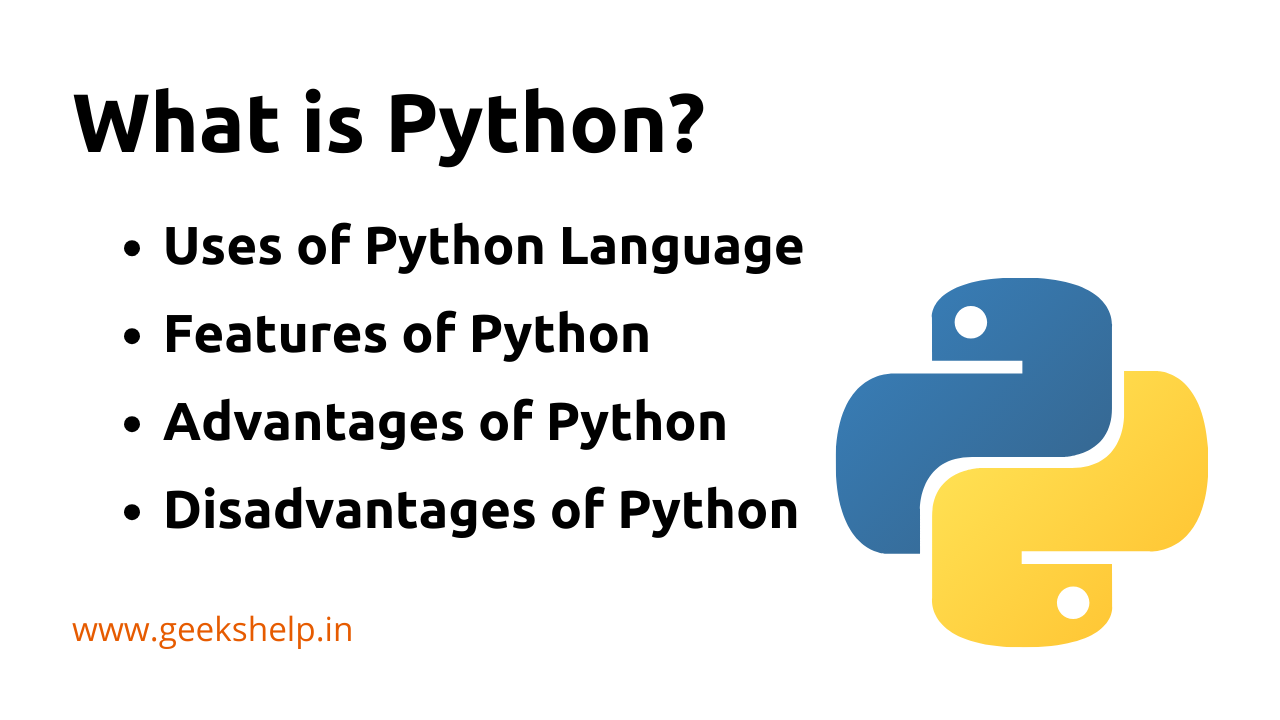What is Python?
Python is a high-level, general-purpose, object-oriented, interpreted, and most popular programming language. And it was released in 1991 and was created by Guido Van Rossum. Python is a strongly typed and dynamically typed language.

It is easy to use and simple to learn. A programming beginner can easily learn Python. Python provides lots of high-level data structures and it is an easy-to-learn yet powerful and versatile scripting language. Python is a multipurpose programming language because it can be used in web applications, 3D CAD, Machine Learning, Artificial Intelligence, etc.
What is Python Programming language used for
Python is a widely used programming language and it is used to perform different tasks. Python is commonly used for building websites, software, task automation, data analysis, and more. Here is the list of where Python is most commonly used:
1. Web Development (Server-Side)
2. Machine Learning
3. Software Development
4. Artificial Intelligence
5. Game Development
6. Desktop GUI
7. Script Writing and Automation
8. Data Science
Features of Python Programming Language
1. Simple
Python emphasizes a focus on readability and simplicity, making it simple for developers to write and maintain code.
2. Dynamic Typed
Python is a dynamically typed language that allows flexibility by not requiring variable type declarations.
3. Object-Oriented Programming (OOP)
Python is an object-oriented programming language that allows the creation and manipulation of classes, objects, and inheritance.
4. High-Level Language
Python is a high-level programming language which makes it more accessible for beginners and anyone can learn it with very basic knowledge of programming languages.
5. Interpreted Language
Python is an Interpreted Language which means the code written in Python language will be executed line-by-line which makes easy debugging and facilitating development.
6. Versatility
Python is suitable for a wide range of applications, including web development, data science, artificial intelligence, and automation.
7. Open Source
Python programming is an open-source, which means that developers can freely view, modify, and distribute the source code.
8. High-Level Data Structures
Python provides high-level data structures such as lists, sets, and dictionaries that simplify difficult data processing operations.
9. Large Developers Community
The Python community is a wide-ranging and active community, providing developers with resources, forums, and substantial documentation.
10 Increased Productivity
Python programming has a simple syntax and powerful libraries which can help developers to write code more efficiently and faster.
Advantages and Disadvantages of Python Programming Language
Advantages
1. Readability: Python focuses on code readability and simplicity, making it easy to understand and maintain. Its concise syntax and indentation structure help to improve readability while reducing the cost of program maintenance and development.
2. Extensive Standard Library: Python contains a large standard library of modules and packages for a variety of uses, including string operations, file I/O, network protocols, and more. This reduces the need to create code from scratch for many basic tasks.
3. Platform Independence: Python is a cross-platform language, which means it can be used on a variety of operating systems including Windows, macOS, and Linux without requiring any code changes. It makes it easier to create programs that can work on multiple platforms.
4. Large Community and Support: Python has a large and engaged developer community that helps the language evolve by sharing libraries, frameworks, and resources. This community assistance ensures that developers can easily solve their difficulties and keep updated on the latest developments and best practices.
5. Versatility: Python is a versatile programming language that may be used for a variety of purposes, including web development, data analysis, artificial intelligence, machine learning, scientific computing, and more. Its flexibility makes it a popular choice among both new and experienced developers.
6. Ease of Learning: Python's clear and straightforward syntax makes it an excellent language for beginners to learn programming rules. Its simplicity and comprehensive documentation make learning easier, allowing beginners to quickly understand the basics of programming.
Disadvantages
1. Performance: Python can be slower to execute than compiled languages such as C++ or Java. This is mainly due to its interpreted nature and dynamic typing, which might result in reduced performance for CPU-intensive tasks or applications that require real-time processing.
2. Global Interpreter Lock (GIL): Python's GIL prevents multiple native threads from processing Python bytecodes at the same time, which can reduce the concurrency of multi-threaded Python programs. This can become an obstacle for performance-critical applications that depend substantially on parallel processing.
3. Not Ideal for Mobile Development: Python can be used to build mobile apps using frameworks such as Kivy or BeeWare, but it is not as popular in the mobile development industry as languages like Java or Swift. This limits its applicability to some mobile application initiatives.
4. Design Restrictions: Python's dynamic typing and high-level abstractions, while useful in many situations, can occasionally result in design constraints or drawbacks, particularly in large-scale projects where strong type and explicit declarations may be desired for greater code maintainability and dependability.
5. Packaging and Distribution: Packaging and distributing Python applications can be difficult, particularly when dealing with dependencies and versioning problems. While tools such as pip and virtualenv can help manage dependencies, maintaining compatibility across multiple environments can be time-consuming.
6. Limited Capabilities in Resource-Constrained Environments: Python may not be the best option in situations with limited resources, such as embedded systems or high-performance computer groups because it consumes more memory and performs slower than lower-level languages that are optimized for such environments.



